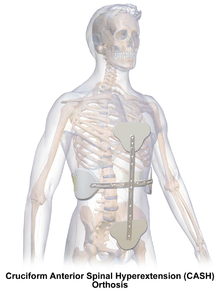Spinal fracture
| Spinal fracture | |
|---|---|
| Synonyms | Vertebral fracture, broken back |
 | |
| Lateral spine X-ray showing osteoporotic wedge fractures of L1/2 | |

A spinal fracture, also called a vertebral fracture or a broken back, is a fracture affecting the vertebrae of the spinal column. Most types of spinal fracture confer a significant risk of spinal cord injury. After the immediate trauma, there is a risk of spinal cord injury (or worsening of an already injured spine) if the fracture is unstable, that is, likely to change alignment without internal or external fixation.[1]
Types
- Cervical fracture
- Fracture of C1, including Jefferson fracture
- Fracture of C2, including Hangman's fracture
- Flexion teardrop fracture – a fracture of the anteroinferior aspect of a cervical vertebra
- Clay-shoveler fracture – fracture through the spinous process of a vertebra occurring at any of the lower cervical or upper thoracic vertebrae
- Burst fracture – in which a vertebra breaks from a high-energy axial load
- Compression fracture – a collapse of a vertebra, often resulting in the form of a wedge-shape due to larger compression anteriorly
- Chance fracture – compression injury to the anterior portion of a vertebral body with concomitant distraction injury to posterior elements
- Holdsworth fracture – an unstable fracture dislocation of the thoracolumbar junction of the spine
- Distraction is an where there is pulling apart of the vertebrae.[2] Distraction injuries generally cause breaks in osseous and ligamentous supporting structures, and are therefore generally unstable.[3] A distraction injury on the posterior side of a vertebra can lead to a compression fracture on its anterior side.[3]
Risk of spinal cord injury
Vertebral fractures of the thoracic vertebrae, lumbar vertebrae or sacrum are usually associated with major trauma and can cause spinal cord injury that results in a neurological deficit.[4]
Thoracolumbar injury classification and severity score
The thoracolumbar injury classification and severity score (TLICS) is a scoring system to determine the need to surgically treat a spinal fracture of thoracic or lumbar vertebrae. The score is the sum of three values, each being the score of the most fitting alternative in three categories:[5]
Injury type
- Compression fracture - 1 point
- Burst fracture - 2 points
- Translational rotational injury - 3 points
- Distraction injury - 4 points
Posterior ligamentous complex
- Intact - 0 points
- Suspected injury or indeterminate - 2 points
- Injured - 3 points
Neurology
- Intact - 0 points
- Spinal nerve root injury - 2 points
- Incomplete injury of cord/conus medullaris - 3 points
- Complete injury of cord/conus medullaris (complete) - 2 points
- Cauda equina syndrome - 3 points
A TLICS score of less than 4 indicates non-operative treatment, a score of 4 indicates that the injury may be treated operatively or non-operatively, while a score of more than 4 means that the injury is usually considered for operative management.[5]
References
- ↑ "Fracture". MDguidelines by the American Medical Association. Retrieved 2017-10-26.
- ↑ Augustine, J.J. (21 November 2011). "Spinal trauma". In Campbell, J.R. International Trauma Life Support for Emergency Care Providers. Pearson Education. ISBN 978-0-13-300408-3.
- 1 2 Clark West, Stefan Roosendaal, Joost Bot and Frank Smithuis. "Spine injury - TLICS Classification". Radiology Assistant. Retrieved 2017-10-26.
- ↑ Mirghasemi, Alireza; Mohamadi, Amin; Ara, Ali Majles; Gabaran, Narges Rahimi; Sadat, Mir Mostafa (November 2009). "Completely displaced S-1/S-2 growth plate fracture in an adolescent: case report and review of literature". Journal of Orthopaedic Trauma. 23 (10): 734–738. doi:10.1097/BOT.0b013e3181a23d8b. ISSN 1531-2291. PMID 19858983.
- 1 2 Buck Christensen. "Thoracolumbar Injury Classification and Severity (TLICS) Scale". Medscape. Retrieved 2017-10-26. Updated: Dec 09, 2014
External links
| Classification | |
|---|---|
| External resources |